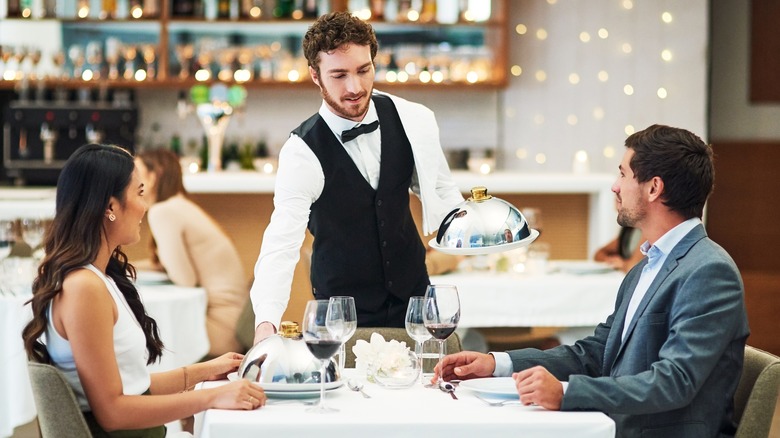What Does Silent Service Mean In A Restaurant And Could You Experience It?
The term "silent service" may sound foreboding — as if the waitstaff decided to shun you for bad manners or for asking for an extra side of ranch. In reality, it's nothing so severe, and you're unlikely to encounter it unless you're dining at a very high-end restaurant where servers read subtle cues, like how your silverware is placed. While it's helpful to know proper fine-dining etiquette, it's not a requirement.
The general definition of silent service is when a server anticipates your needs without being asked. A couple of examples are filling up a water glass or removing a plate once it's been cleaned, all without being prompted. Experienced front-of-house staff are always watching how much beverage is left in a glass, if it's time for more bread, chips, or a dessert menu, and other signs that indicate what the diner needs.
Proactiveness might not always come naturally to those just starting out, but once you start looking for it as a customer, it's easy to tell who's been waiting tables or bartending the longest. Really nice restaurants want a peripatetic front-of-house that is everywhere, and yet nowhere at the same time; around when you need them, but not overly intrusive.
Communicating with fork and knife
No, communicating with your fork and knife doesn't mean gesturing with your cutlery for seconds, or waving down a waiter with a fork in hand and pointing toward an empty martini glass for a refill. The more specific definition of silent service refers to how you place your knife and fork on a plate.
If you set your knife and fork at 45-degree angles toward the center of your plate, tips near but not touching, that means you're taking a break. If you interlock the knife and fork tines, it means you didn't like the dish. Knife and fork in a cross means you're ready for the next plate, while knife and fork parallel, pointing north, means you've finished. Knife and fork parallel but pointing right signals the dish was "excellent."
There are also ways to communicate with the waitstaff via your napkin, but again, don't expect Brian at the local bar and grill to know why you left a napkin on your chair. He may just put it back on the table. However, if you find yourself at a place that seems to decipher napkin placement, leave it on your chair to let the server know you're just stepping away for a second. Some places will even go so far as to refold it for you. If you want to signal that you've finished, place the napkin to the left of your plate.
How to tell if a restaurant has silent service
There are many ways to wait tables, but every restaurant has its own specific standards. If you notice guests and diners communicating without speaking, don't feel pressured to follow suit, as silent service isn't commonplace. Chances are if you're in an establishment that knows those rules, they place a premium on service in general and will follow the guests' lead, so don't get flustered over when to put your menu down, or where to put your utensils or napkin.
At the end of the meal, waitstaff still work for tips, and it's antithetical to the job to correct or reprimand a guest for unfamiliar and rarely used cutlery practices. They might say something if you snap your fingers for their attention, or refer to all waiters as "champ," "buddy," or "garçon," but that's more of a you problem than theirs.
Most hospitality and customer-facing workers can make small talk, and will likely engage as the customer does. Some people don't like to chat while getting a haircut — or simply aren't in the mood — and that's fine. The same applies at restaurants — if you're talkative, it's more likely the server will be too. Conversely, if a hush comes over the table every time they check in, the exchanges will follow suit.



